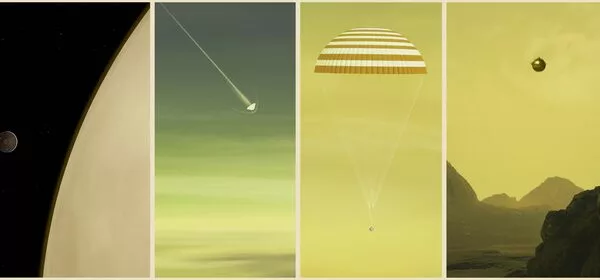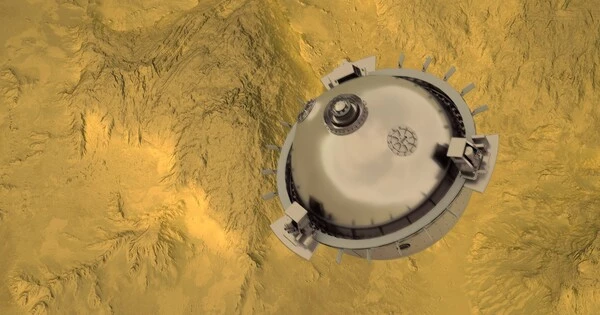NASA scientists and engineers reveal new information about the Deep Atmosphere Venus Investigation of Noble gases, Chemistry, and Imaging (DAVINCI) mission, which will descend through Venus’s layered atmosphere to the planet’s surface in mid-2031. The DAVINCI mission is the first to study Venus with both spacecraft flybys and a descent probe.
NASA scientists and engineers reveal new details about the Deep Atmosphere Venus Investigation of Noble gases, Chemistry, and Imaging (DAVINCI) mission, which will descend through the layered Venus atmosphere to the planet’s surface in mid-2031. The DAVINCI mission is the first to study Venus with both spacecraft flybys and a descent probe.
For the first time, DAVINCI, a flying analytical chemistry laboratory, will measure critical aspects of Venus’ massive atmosphere-climate system, many of which have been measurement goals for Venus since the early 1980s. It will also provide the first descent imaging of Venus’s mountainous highlands, mapping their rock composition and surface relief at scales that are not possible from orbit. The mission supports measurements of undiscovered gases found in trace amounts in the deepest atmosphere, such as the key ratio of hydrogen isotopes – water components that help reveal the history of water, whether as liquid water oceans or steam in the early atmosphere.
The mission’s carrier, relay and imaging spacecraft (CRIS) has two onboard instruments that will study the planet’s clouds and map its highland areas during flybys of Venus and will also drop a small descent probe with five instruments that will provide a medley of new measurements at very high precision during its descent to the hellish Venus surface.
These measurements will enable us to evaluate historical aspects of the atmosphere, as well as detect special rock types at the surface, such as granites, while also looking for tell-tale landscape features that could tell us about erosion or other formational processes.
Jim Garvin
“This collection of chemistry, environmental, and descent imaging data will paint a picture of the layered Venus atmosphere and how it interacts with the surface in the mountains of Alpha Regio, which is twice the size of Texas,” said Jim Garvin, lead author of the Planetary Science Journal paper and DAVINCI principal investigator at NASA’s Goddard Space Flight Center in Greenbelt, Maryland. “These measurements will enable us to evaluate historical aspects of the atmosphere, as well as detect special rock types at the surface, such as granites, while also looking for tell-tale landscape features that could tell us about erosion or other formational processes.”
DAVINCI will use three Venus gravity assists to save fuel by changing the speed and/or direction of the CRIS flight system using the planet’s gravity. The first two gravity assists will prepare CRIS for a Venus flyby to perform remote sensing in ultraviolet and near-infrared light, collecting over 60 gigabits of new data about the atmosphere and surface. The third Venus gravity assist will prepare the spacecraft for entry, descent, science, and touchdown, as well as follow-up transmission to Earth.
The first flyby of Venus will be six and a half months after launch, and it will take two years to get the probe into position for entry into the atmosphere over Alpha Regio under ideal lighting at “high noon,” with the goal of measuring the landscapes of Venus at scales ranging from 328 feet (100 meters) down to finer than one meter. Such scales allow for lander-style geologic studies in Venus’s mountains without the need for landing.

The probe flight system, along with the titanium three-foot (one-meter) diameter probe safely encased inside, will be released once the CRIS system is about two days away from Venus. At about 75 miles (120 kilometers) above the surface, the probe will begin to interact with Venus’s upper atmosphere. After releasing its heat shield 42 miles (67 kilometers) above the surface, the science probe will begin scientific observations. With the heatshield removed, the probe’s inlets will ingest atmospheric gas samples for detailed chemistry measurements similar to those made by the Curiosity rover on Mars.
Hundreds of images will be acquired by the probe during its hour-long descent to the surface, as soon as it emerges beneath the clouds at around 100,000 feet (30,500 meters) above the local surface.
“The probe will land in the Alpha Regio mountains but will not be required to operate once there because all of the required science data will be collected before reaching the surface,” said Stephanie Getty, Goddard’s deputy principal investigator. “If we survive the landing at about 25 miles per hour (12 meters per second), we could have up to 17-18 minutes of surface operations under ideal conditions.”
DAVINCI is tentatively scheduled to launch June 2029 and enter the Venusian atmosphere in June 2031.
“No previous mission within the Venus atmosphere has measured the chemistry or environments at the detail that DAVINCI’s probe can do,” said Garvin. “Furthermore, no previous Venus mission has descended over the tesserae highlands of Venus, and none have conducted descent imaging of the Venus surface. DAVINCI will build on what Huygens probe did at Titan and improve on what previous in situ Venus missions have done, but with 21st century capabilities and sensors.”
NASA DAVINCI’s principal investigator institution, Goddard, will perform mission project management, provide science instruments, and project systems engineering to develop the probe flight system. Goddard also leads the project science support team, which includes scientists from across the United States. DAVINCI and other Discovery Program class missions supplement NASA’s larger “flagship” planetary science explorations, with the goal of achieving outstanding results by launching more smaller missions with fewer resources and shorter development times. The Planetary Missions Program Office at Marshall Space Flight Center in Huntsville, Alabama, manages them for NASA’s Planetary Science Division.





